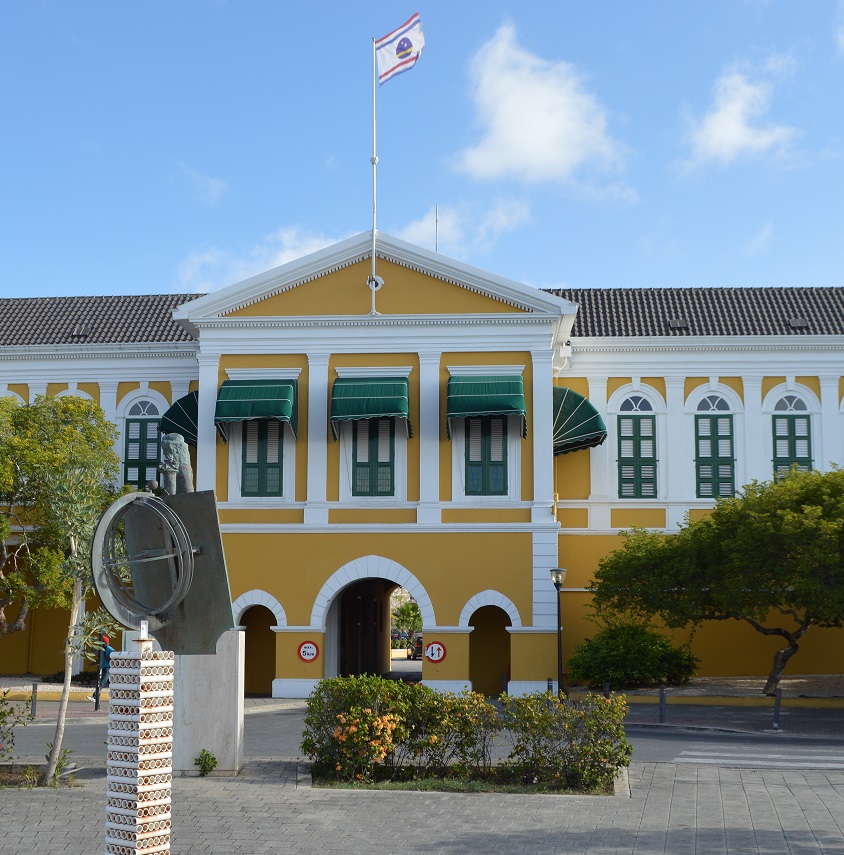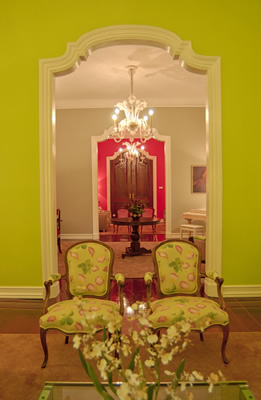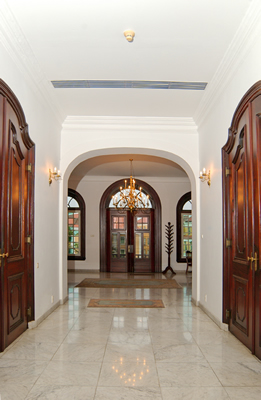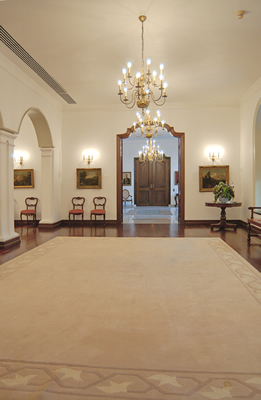 The Governor’s Palace is both a residence and a place of work. It is where the Governor receives visitors and swears in new ministers and members of the High Councils of State, and also where other occasions such as naturalisation ceremonies take place.
The Governor’s Palace is both a residence and a place of work. It is where the Governor receives visitors and swears in new ministers and members of the High Councils of State, and also where other occasions such as naturalisation ceremonies take place.
 The Palace has a long history. In 1634 the Dutch, led by Johan van Walbeeck, captured Curaçao from Spain. It was seen as a strategic location from which to harry the Spanish. Curaçao, like Bonaire, was also important for salt production. The first priority was to build a fort to defend the island. The mouth of St Anna Bay was selected as the perfect spot. Fort Amsterdam was built there, at the centre of the island, and the city of Willemstad grew up around it.
The Palace has a long history. In 1634 the Dutch, led by Johan van Walbeeck, captured Curaçao from Spain. It was seen as a strategic location from which to harry the Spanish. Curaçao, like Bonaire, was also important for salt production. The first priority was to build a fort to defend the island. The mouth of St Anna Bay was selected as the perfect spot. Fort Amsterdam was built there, at the centre of the island, and the city of Willemstad grew up around it.
The Palace stands on the site where the first fort was built in 1635. Within two years, the first residence of the representative of the Dutch West India Company had been added. This forerunner of the Governor’s Palace was a two-storey wooden building constructed mainly from materials shipped from Amsterdam.
Not long after, the wooden building was replaced with a stone house that forms the heart of the current Palace. The style has changed considerably over the centuries. The oldest part consisted of a pavilion at the front, divided into two wings on account of its length, flanking a central passage. A second pavilion with an impressive exterior double staircase was added at the rear soon after. The Palace was enlarged with an open gallery overlooking the port in 1765. The building then remained unchanged for about 100 years. In 1868-1870, extensive renovation plans were drawn up. Their main purpose was to restore the Palace exterior’s grandeur and create more space. In the end, however, the renovation was limited to incorporating the open gallery into the main building, transforming the planned balcony room into a ‘hanging’ balcony and decorating the front and rear façades with classical features. The renovation deprived the rear of its original simplicity.
In 1868-1870, extensive renovation plans were drawn up. Their main purpose was to restore the Palace exterior’s grandeur and create more space. In the end, however, the renovation was limited to incorporating the open gallery into the main building, transforming the planned balcony room into a ‘hanging’ balcony and decorating the front and rear façades with classical features. The renovation deprived the rear of its original simplicity.
 The roof was also renovated and its elegant curved beams were removed. Even this refurbishment could not make the building fit to be a residence in the long term, so Governor Barge (1890-1901) decided another renovation was necessary. While work was in progress, he and his family lived in a country house known as Quintz, now Groot Davelaar. This refurbishment apparently answered the needs of the time because no major renovation was required until Professor René Römer was governor between 1983 and 1990. The governor temporarily moved out of the Palace and into another country house, Santa Barbara.
The roof was also renovated and its elegant curved beams were removed. Even this refurbishment could not make the building fit to be a residence in the long term, so Governor Barge (1890-1901) decided another renovation was necessary. While work was in progress, he and his family lived in a country house known as Quintz, now Groot Davelaar. This refurbishment apparently answered the needs of the time because no major renovation was required until Professor René Römer was governor between 1983 and 1990. The governor temporarily moved out of the Palace and into another country house, Santa Barbara.
Today, the aim is to preserve the historic Governor’s Palace in Willemstad for future generations. However, 17th-century construction methods, with cement made from crushed coral, mean the Palace walls are being disfigured by efflorescence. The salt in the coral absorbs so much moisture that some parts of the walls have to be repainted more than once a year to keep them smart and presentable. It therefore comes as no surprise that the Palace is a matter of almost daily concern for the Office of the Governor.